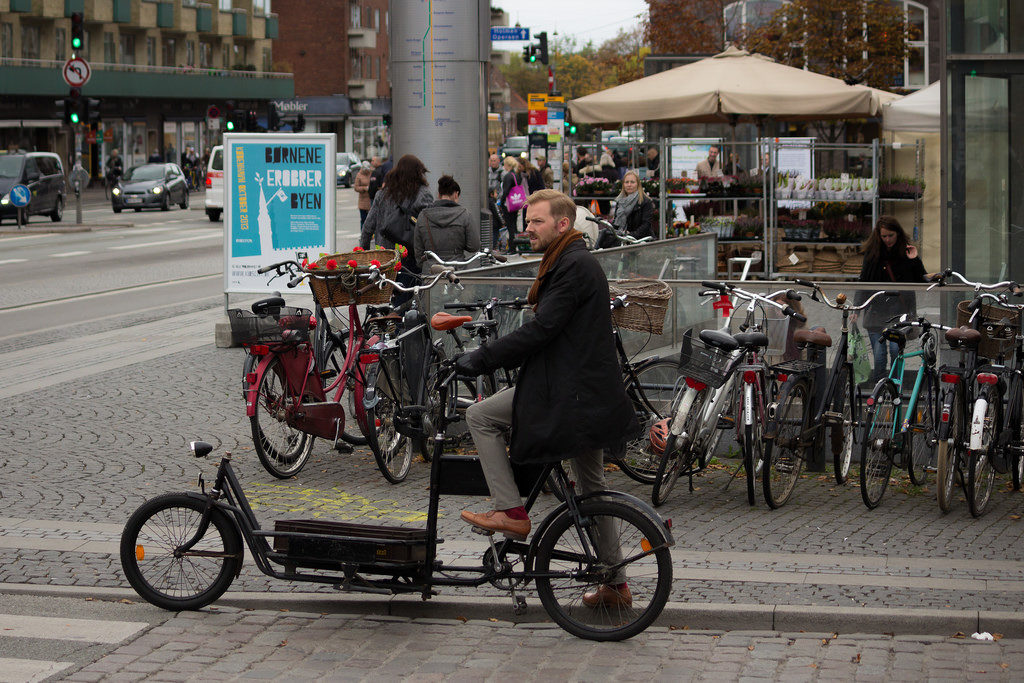Over the last few years Copenhagen has become world famous for its incredible biking culture. It is no secret that there are a LOT of bikes in Copenhagen. The most commonly cited statistic is that more than 50% of Copenhageners bike daily to work or school. That, in and of itself, is pretty spectacular – but it is also just the tip of the iceberg when it comes to the amazing bike-centered things going on in Copenhagen. After a somewhat rocky roll out, last year’s big announcement introduced Copenhagen’s new and heavily updated city bike program which replaced the recently retired free bike program. While the reception has been luke-warm to the new bikes due to their cost and the fact that they are no longer free, the updated bikes possess GPS, electric engines, electronic maps and a plethora of perks for the price of about $4 an hour.
The city of Copenhagen has also undertaken and recently completed a number of expanded bike lanes many of which are now roughly the same size as traditional car lanes. Other projects include cycle superhighways, bike-only stop lights, lean-rails for bikers waiting at lights, and proposals for built in street-based notifications to help bicyclists time their speed to avoid red lights and delays. The latest of these safety innovations was introduced September 4th (in Danish) and focuses on tackling an emergent problem – the collision of Copenhageners exiting public buses and bicyclists who, while technically required to stop and yield to those disembarking from buses, don’t always remember to stop. Copenhagen’s solution? An innovating plan to build lights into the bicycle paths which will direct bikers to stop when a bus is present and unloading passengers. In effect, this is a modern and updated take on the old school-bus “STOP” sign. It’s precisely because of initiatives like this that bike-usage in Copenhagen is continuing to grow. Biking is safe, incredibly good for you, convenient and a priority across all levels of society.
Part of what makes biking in Copenhagen such an organic experience is the fact that it is socially integrated into the culture. Many workplaces have a changing room set aside for bikers and it is very common to see top level business professionals in suits biking to/from work. One estimate even suggests that 60%+ of the Danish members of parliament bike to work at the country’s capital building (Christiansborg Palace). To contextualize that further just think about how tickled Americans were by the fact that Joe Biden commutes using public transportation – it’s a whole different world in Denmark! The Danish postal service also operates more than 300 postal bikes which service a large portion of the city’s daily postal delivery (my apartment included). They’re pretty cool bikes with an electrical supplement, all weather bags, and a special design to hold all that mail. And, speaking of all weather bags, the Danes really do bike in all types of weather with about 75% biking year-round. A trend which is made much easier by specialized machinery and an army of municipal vehicles that prioritize keeping the bike lanes clear and ice-free year round.
In place of mini vans you’ll also find that many Danish families living in the city have opted for a type of cargo bike which locals call a Christiania bike. With three wheels and a big box in front with room for several kids, a dog, a romantic partner, or a good friend these Christiania bikes are the city’s workhorses. The latest stats indicate that more than 25% of families with two or more kids own a Christiania bike and use it regularly – not a bad way to grow up ehh?
So, what happens when you have more than half of your population biking on a daily basis? You get some pretty incredible bike traffic stats. Three of the busiest bike streets in Copenhagen include Knippelsbro, Nørrebrogade, and Langebro which boast on average 40,700, 36,000, and 30,200 cyclists per day. Which, as you can imagine, requires a lot of bikes – roughly 650,000 for the Copenhagen area in fact. Unfortunately, despite amazingly low levels of crime in Copenhagen one of the few things that do get stolen regularly are bikes with more than 18,000 bikes reported stolen each year. Though when cross referenced against the 16,000 abandoned/forgotten bikes which are re-claimed or disposed of by the municipality I suppose it isn’t that bad. Wondering how bikes get forgotten? When you’ve got 650,000 bikes which look similar and a vibrant drinking culture even the Danes, which are often more stable biking than walking while drunk, have almost all lost or “donated” at least one bike over the years.
The folks over at Cykelvalg.dk put together the following awesome infographic which I’ve referenced heavily for this post. Many of the stats used in this blog post also come from Visit Copenhagen’s page on Copenhagen’s bike culture.
So, next time you hear that “Copenhagen is an awesome biking city” hopefully you’ll have a better appreciation and understanding for not only what that means, but the investment from the city and the local population which makes Danish bicycle culture an exciting reality. You can also find videos I’ve recorded of Copenhagen’s biking culture on youtube here and here.
Have a fun fact about biking in Denmark of your own? Feel free to share it in a comment!
